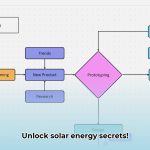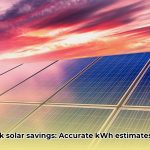Going solar is a great way to save money and help the planet, but what do you do when the sun isn’t shining? This guide explains the best ways to store the extra energy your solar panels produce so you can use it later. We’ll break down different storage options, compare costs effectively, show you how to install a system with clear steps, and give you actionable tips to maximize your investment returns. We’ll even look at emerging solar battery technology, so you can plan for the future and keep your energy bills low. Whether you’re just starting to think about solar or you already have panels, this guide will empower you to make informed choices and realize significant savings. For more in-depth information, check out this helpful guide on [solar energy storage](https://txgenco.com/how-to-store-solar-energy/).
How Do You Store Solar Energy?
So, you’ve got solar panels soaking up the sun’s rays, but what happens when the sun dips below the horizon? That’s where storing your solar energy becomes crucial. It’s not just about saving energy; it’s about maximizing your investment and potentially slashing your electricity bills. This guide breaks down the ins and outs of solar energy storage, making it easy to understand, even if you’re not an expert. We’ll explore everything from battery types to thermal storage, so you can make the right choice for your home and budget.
Sizing Up Your Energy Needs: A Personal Energy Audit
Before jumping into solutions, let’s figure out how much stored energy you really need, including assessing residential solar energy storage. How much solar power are your panels generating on a sunny day? How much electricity does your home typically use each day? A simple home energy audit can provide some surprising insights – you might be amazed at what you discover! This involves tracking your energy consumption over a week or two, paying attention to peak usage times. Do you want to be entirely off-grid, minimizing dependence on the power company? Or are you mainly looking to reduce those high evening electricity costs? Answering these questions helps you choose the right storage system for your specific needs and goals, ensuring optimal efficiency and savings.
Home Battery Storage: The Popular Pick
For most homeowners, a home battery system is probably the most practical way to store solar energy, offering solutions for peak demand periods. Lithium-ion batteries are currently the most common choice. They’re relatively affordable, you can adjust their size to match your energy needs, and they have a decent lifespan. Think of them as a big, rechargeable battery for your entire house. Leading brands include Tesla Powerwall, LG Chem, and Sonnen.
Pros:
- Reliable technology with a proven track record.
- Scalable; you can increase their capacity as your energy needs grow.
- They have a relatively long lifespan (10-15 years for newer models, although this can vary).
- Reduce your reliance on the power grid, potentially saving you money and providing backup power during outages.
- Often come with smart energy management features for optimized usage.
Cons:
- The upfront cost can be significant (though decreasing).
- Their lifespan can be affected by how often you use them and the climate where you live.
- There are environmental concerns about recycling the batteries at the end of their life, though recycling programs are improving.
- Installation requires a qualified professional, adding to the overall cost.
Beyond Batteries: Other Storage Methods
While batteries are incredibly popular for home use, they aren’t the only way to store solar energy. Larger operations often use different methods, some of which are less common for residential use but are crucial for large-scale solar farms. These include thermal storage systems.
-
Thermal Storage: This clever approach uses the sun’s heat – think of it like a giant solar water heater – to heat water, molten salt, or another medium that’s then stored for later use. This stored heat can then be used to warm your home, provide hot water, or even generate electricity when needed. This is most effective in climates with high solar irradiance.
-
Mechanical Storage: Methods like pumped hydro storage cleverly use excess solar energy to pump water uphill to a reservoir. When you need power, the water flows downhill, turning a turbine to generate electricity. It’s essentially a very large-scale water wheel! This method is most suitable for larger-scale projects, requiring specific geographical features (elevation differences) that limit its widespread use for residential applications. Compressed air energy storage (CAES) is another mechanical method, but also less common for homes.
Choosing Your Storage System: Key Considerations
Picking the right solar energy storage solution depends on several key things, including commercial scale systems and residential needs.
-
Your Budget: Battery systems involve a significant upfront investment, so it’s important to understand your financial resources and what you can realistically afford. Aim to get quotes from multiple installers to compare pricing and financing options.
-
Your Energy Needs: How much energy do you need to store? The answer to this depends entirely on your home energy consumption and solar panel output. Calculate your average daily energy consumption and size your battery accordingly.
-
Available Space: Larger systems need more space for installation, so consider the physical limitations of your property. Batteries can be wall-mounted or floor-mounted, but require adequate ventilation and protection from extreme temperatures.
-
Local Regulations and Incentives: Check your local energy policies and see if there are any net metering programs, rebates, tax credits, or other financial incentives that could sweeten the deal. These can significantly reduce the overall cost of your system.
-
Warranty and Lifespan: Review the warranty terms and expected lifespan of the battery system before making a decision. A longer warranty and a proven track record are indicators of a reliable product.
Making it All Work Together: Smart Energy Management
Smart energy management systems are critical for maximizing your solar investment. Think of them as the brains of your energy operation. These systems intelligently manage the flow of energy between your solar panels, your battery, and the electricity grid to ensure you use as much solar power as possible. This minimizes how much power you have to buy from the grid, saving you money and reducing your carbon footprint, all while optimizing your home’s overall energy usage. Advanced systems can even learn your energy consumption patterns and automatically adjust settings for optimal performance.
It’s important to remember that the field of solar energy storage is constantly advancing. New battery technologies, such as solid-state batteries, are always being developed, thermal storage designs are improving, and smarter grid integration is happening all the time. Staying up-to-date on the latest developments will help you get the most out of your solar energy system. The technology is rapidly evolving, so keep your eyes peeled for exciting advancements.
How to Compare Residential Solar Battery Storage System Costs and ROI Based on Net Metering Policies
Key Takeaways:
- The best choice between net metering and a home battery depends on many factors: your energy consumption, net metering policy, and time-of-use rates.
- Full retail net metering offers the highest financial returns initially without batteries in many scenarios, but this is changing.
- Time-of-use and avoided-cost net metering often favor battery storage, especially as rates become more volatile.
- Battery storage provides energy independence and resilience during outages, a non-financial benefit often overlooked.
- Battery costs are decreasing, making them a more viable option for more homeowners over time.
- Accurate ROI calculations require detailed financial modeling specific to your situation, using real-time data.
- Net metering policies and electricity prices can change over time – factor future uncertainties into your decision-making process.
Understanding Your Net Metering Policy
Before diving into costs and return on investment (ROI), you need to understand your utility’s net metering policy, including solar battery ROI. Net metering allows you to sell excess solar power back to the grid. But policies vary widely. Some offer full retail credit for your exported energy, while others provide a lower, “avoided cost” rate. Time-of-use rates—where electricity prices fluctuate throughout the day—also play a significant role. Some utilities are also implementing “net billing,” where you are paid less for the solar energy you send back to the grid than you pay to consume it. How to compare residential solar battery storage system costs and ROI based on net metering policies requires understanding these nuances.
Evaluating Battery System Costs
Battery system costs depend on several factors, including capacity (measured in kilowatt-hours, kWh), inverter type (AC-coupled vs. DC-coupled), battery chemistry, and installation costs. Get quotes from multiple reputable installers. Compare apples to apples – ensure you’re comparing systems with similar capacities, features, and warranties. Don’t forget to factor in potential replacement costs after the usual 10-15 year lifespan, as well as any ongoing maintenance fees.
Calculating Your ROI
Calculating ROI for a home battery system is more complex than simply comparing its upfront cost to potential savings. Here’s a simplified approach:
- Estimate your energy consumption: Track your electricity usage to understand your baseline. Use your utility bills and smart meter data for accuracy.
- Assess your solar production: Calculate how much electricity your solar panels generate, considering seasonal variations. Use solar production estimates from your installer.
- Factor in net metering (or net billing): Calculate the value of excess energy sold back to the grid under your utility’s policy.
- Project battery performance: Determine how much of your energy needs the battery will meet. Estimate how much you can discharge the battery during peak hours instead of buying from the grid.
- Consider electricity price fluctuations: Account for time-of-use rates if applicable.
- Include all costs: Factor in all initial investment, installation, permitting, and potential maintenance or replacement costs.
- Calculate your savings: Subtract your total projected electricity bill with a battery from your projected bill without.
- Determine ROI: Divide your total savings by the total cost to get your ROI percentage.
Your ROI projection will depend heavily on your energy usage, local electricity prices (which are constantly rising), and your net metering policy. A financial model tailored to your individual situation will give you the most accurate results. Many solar installers offer these services.
Net Metering vs. Battery Storage: A Simple Analogy
Imagine a water well and a water tower. Net metering is like selling excess well water back to your neighbor at a potentially discounted price. A battery is like building a water tower; you can store water for later use, ensuring you always have access to it, regardless of whether your neighbor buys your excess well water. The costs of digging the well and building the tower are different, and their effectiveness depends on your water needs and your neighbor’s price. The key difference is that with net metering, you rely on your neighbor’s willingness to buy your excess water. With a battery, you are self-sufficient.
Long-Term Considerations
Net metering policies are ever-changing. Many states are phasing out or reducing incentives for full retail net metering. Time-of-use rates are also becoming more common. Therefore, a home battery system might become more economically advantageous in the long run, offering greater energy independence even as net metering policies evolve. Consider these long-term aspects when weighing your options. Furthermore, the increasing frequency and severity of power outages due to climate change make battery backup an increasingly valuable asset.
Optimizing Residential Solar Energy Storage for Peak Demand Periods
Key Takeaways:
- Residential solar battery storage significantly reduces electricity bills by using stored solar power during peak demand, offsetting costly time-of-use rates.
- Lithium-ion batteries are currently the top choice for home energy storage, offering a good balance of cost, performance, and lifespan. Different lithium-ion chemistries offer different advantages.
- Optimizing Residential Solar Energy Storage for Peak Demand Periods requires careful consideration of battery size, energy consumption patterns, and local utility policies.
- Smart home technology and advanced energy management systems maximize self-consumption and minimize reliance on the grid.
- Understanding Net Metering policies is crucial for maximizing financial benefits, as is understanding demand response programs offered by your utility.
Understanding Your Energy Needs
Before diving into battery solutions, understand your household’s energy use, including demand response programs. How much energy do you consume daily? When is peak demand—typically evenings and early mornings? Understanding your baseload consumption (the minimum amount of power you use even when appliances are off) is also helpful. This information, alongside your solar panel output, dictates the ideal battery size. Oversizing is costly; undersizing leaves you needing grid power. A professional energy audit can uncover hidden energy drains.
Choosing the Right Battery Technology
Several battery technologies exist for home solar energy storage. Lithium-ion batteries are dominant due to high energy density, longevity, and decreasing costs. Lithium Iron Phosphate (LFP) batteries are known for safety and long lifespan, while Nickel Manganese Cobalt (NMC) batteries offer higher energy density. Lead-acid batteries are cheaper upfront but less efficient and shorter-lived. Flow batteries offer longer lifespans and are non-flammable but are currently more expensive and less readily available. Your choice depends on budget, energy needs, and long-term goals.
Optimizing Residential Solar Energy Storage for Peak Demand Periods: Strategies for Success
Smart energy management systems are game-changers. These systems monitor energy usage in real-time, intelligently discharging stored solar power during peak hours. This “peak shaving” drastically reduces your reliance on expensive grid electricity. Some systems can also predict energy usage based on weather forecasts and adjust battery usage accordingly. Think of it as a personal power plant manager working 24/7.
Here’s a step-by-step guide for maximizing your home solar battery system:
- Conduct a thorough energy audit: Analyze your electricity bills and usage habits to pinpoint peak demand times.
- Size your battery system appropriately: Consider your energy needs, solar panel output, and peak demand to determine suitable battery capacity. Don’t over- or under-size.
- Install a smart energy management system: These systems optimize power flow, prioritizing self-consumption and minimizing grid electricity use. Make sure it is compatible with your battery and solar panels.
- Explore time-of-use (TOU) electricity rates: If your utility offers TOU rates, charge your battery during off-peak hours to take advantage of lower prices. Program your energy management system to automatically optimize for TOU rates.
- Regularly monitor your system’s performance: Track energy usage, battery charge levels, and system efficiency to identify areas for optimization. Most smart energy management systems provide detailed monitoring tools.
- Maintain your battery system: Follow manufacturer recommendations for maintenance to ensure optimal performance and prolong battery lifespan. This may include periodic inspections and cleaning.
The Role of Net Metering
Net metering policies dictate how much you’re paid for excess solar energy fed back into the grid. Changes in these policies can significantly affect your return on investment. Keep up-to-date with any changes in your area. This is crucial for long-term planning and financial success. Consider joining a local solar advocacy group to stay informed and influence policy decisions.
Addressing Potential Risks
Like any technology, home solar battery systems have inherent risks. Lithium-ion batteries, while prevalent, pose fire risks if not properly installed and maintained. Battery degradation over time is another factor affecting long-term efficiency. Proper installation by qualified professionals and regular maintenance are essential mitigating factors. Choose a reputable installer with experience and a proven track record. Also, ensure your homeowner’s insurance covers solar battery systems.
[Consumer Energy Center]{https://www.consumerenergycenter.org/how-to-store-solar-energy-at-home/}
Commercial-Scale Solar Energy Storage Solutions: A Comparison of Thermal and Mechanical Systems
Want to harness the sun’s power even after sunset on a large scale? That’s where energy storage comes in. But with so many options, how do you choose the right system for your needs? Let’s explore the key players in commercial-scale energy storage, including pumped hydro storage.
Thermal Storage: Harnessing Heat
Thermal storage systems use heat generated from solar energy to store and later release energy. Think of it like a giant thermos, but instead of keeping your coffee warm, it stores and releases heat to generate electricity. These systems are particularly well-suited for concentrated solar power (CSP) plants, where mirrors focus sunlight to heat a working fluid. Common storage mediums include molten salt, high-temperature oil, and concrete.
- Pros: Relatively low degradation, potentially long lifespans (decades), high efficiency in CSP plants.
- Cons: High initial setup costs, lower energy density compared to batteries, geographically limited to areas with high direct solar irradiance.
Mechanical Storage: Moving Parts for Power
Mechanical storage systems, primarily pumped hydro storage (PHS), use water, air, or other materials in motion to store energy. PHS systems pump water uphill (using excess solar power) and then release it downhill to generate electricity when needed. It’s like a giant water wheel, but powered by the sun! Other mechanical systems including compressed air energy storage (CAES) and flywheel systems also play a role, though on smaller scales. CAES stores energy by compressing air into underground caverns or tanks, and then releasing it to drive a turbine. Flywheels store energy in the form of kinetic energy by spinning a heavy rotor at high speeds.
- Pros: Mature technology, proven reliability, large-scale applications, long lifespan (50+ years for PHS).
- Cons: Geographic limitations for PHS (requires suitable topography and water sources), substantial land footprint, environmental concerns related to dam construction. CAES requires suitable geological formations for underground storage.
Batteries: The Powerhouse of the Future
Battery storage solutions are becoming increasingly popular, offering flexibility and quick response times. Lithium-ion batteries are currently dominating the market, but solid-state batteries are on the horizon, promising greater energy density, improved safety, and faster charging times. Imagine a battery large enough to power a whole neighborhood! Other battery chemistries, such as flow batteries and sodium-ion batteries, are also being developed for large-scale applications.
- Pros: High energy density, rapid response times, modular and scalable, diverse applications (grid stabilization, frequency regulation, backup power).
- Cons: Higher degradation rates compared to thermal and mechanical storage, potential supply chain issues for raw materials (lithium, cobalt, nickel), safety concerns related to thermal runaway.
Choosing the Right System: A Balancing Act
The optimal energy storage solution depends on multiple factors:
- Scale: Large-scale energy storage (like a utility-scale plant) may favor PHS or large-scale thermal systems. Smaller installations might lean towards batteries.
- Application: Fast response times? Batteries have an advantage. Long-duration energy storage? Thermal or PHS might be better.
- Cost: Initial investment, operating costs, and maintenance need careful consideration. Each technology has a different cost profile. Conduct a thorough lifecycle cost analysis.
- Environmental Impact: The environmental impact of manufacturing, operation, and disposal plays a crucial role in assessing long-term sustainability. Consider the carbon footprint of battery production and the water usage of PHS.
- Grid Integration: How well can the storage system integrate with the existing power grid? Consider factors like grid stability, reliability, and the ability to provide ancillary services.
Key Takeaways:
- Diversity of Solutions: Various technologies offer unique advantages and disadvantages for commercial-scale solar energy storage.
- Scale Matters: The best solution depends heavily on the project’s scale and specific energy needs.
- Future Outlook: Ongoing technological advancements promise to improve the efficiency, cost-effectiveness, and sustainability of energy storage systems.
- Holistic Approach: A systems-level approach that considers environmental impact, economic viability, and grid integration is essential for successful large-scale solar energy storage deployment.
- Balancing Act: Selecting the optimal storage method requires careful evaluation of initial costs, lifecycle performance, and environmental considerations. Consider a combination of storage technologies to meet diverse needs.
- Wind Energy For Residential: Is It Right For Your Home? - November 28, 2025
- Wind Energy Flyer: Design a Powerful Green Campaign Show - November 26, 2025
- What Types Of Jobs Does Wind Energy Create? - November 23, 2025















